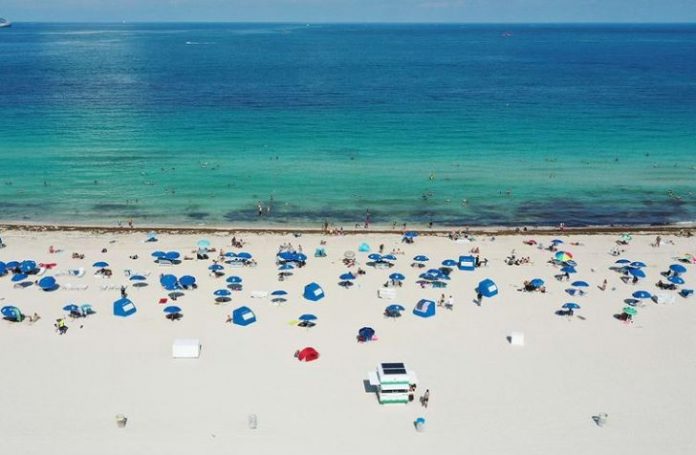Emotional moment for many whose leisure and financial well-being are tied to sandy shores
An aerial drone view as beachgoers take advantage of the opening of South Beach on June 10, 2020 in Miami Beach, Florida.
Miami: Miami’s beaches in South Florida opened for the first time in three months Wednesday, an emotional moment for many residents whose leisure and financial well-being are intrinsically tied to the sandy shores, which were closed due to coronavirus.
“I almost started crying as soon as I came out onto the beach,” said Julie Isaacson, a New Yorker who has lived for 27 years in Miami Beach, located on a barrier island directly across from Miami.
Isaacson, a travel agent, was shaken to her core by the pandemic – which not only cost her her livelihood but also killed one of her friends.
The 63-year-old said the ocean is “an integral part of my mental health and my physical health,” but clarified that she was “in 100 percent agreement with the shutdown.”
COVID-19 was not far from beach-goers’ minds, however, with “social distancing ambassadors” in pink shirts stationed at entrances, reminding visitors to wear masks and maintain social distancing.
Despite being open for the first time since March 23, there was no crowding at the beach – a scene of endless sand, turquoise water and green sargassum algae that begins to accumulate this time of year.
Dozens of beach chairs and umbrellas that are for rent sat empty, with no tourists in sight.
Celebrated for its pastel art deco buildings and intense night life, Miami Beach is only slowly emerging from confinement after the coronavirus forced shop owners and residents into lockdown at the height of peak season, which runs from January to April.
Empty restaurants
Restaurants opened for dine-in only two weeks ago, albeit at half capacity, with the city converting the major Ocean Drive thoroughfare into an outdoor terrace for extra tables.
But protests against police violence and associated curfews meant beach openeings, initially scheduled for last week, were postponed until Wednesday.
Diners are far more intermittent than usual, making reopening an agonizing affair for a city that depends on tourism to survive.
Rodrigo, a waiter working at an Ocean Drive restaurant who declined to give his last name, knows it will be months before Miami Beach’s pre-pandemic throngs return to the area – a normal year sees some seven million tourists pass through the region.
“Now local clients will be valued more, they will be treated better,” the 32-year-old Guatemalan said.
While the rest of Florida began emerging from lockdown the first week of May, the most populous regions in the state’s southeast, where the cities of Miami and Fort Lauderdale are located, chose to open more slowly and in phases due to the heavy coronavirus concentration in the area.
As of Wednesday, Florida had recorded more than 67,000 cases of coronavirus and 2,801 deaths.




